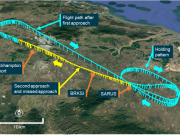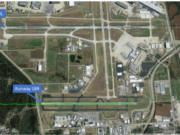Two-thirds of airline pilots responding to an online survey say they routinely discuss fatigue as a safety threat during their preflight and approach briefings, but just over half that number consider their employer “receptive and responsive” to fatigue reports, according to a report in the October issue of Aerospace Medicine and Human Performance.1
Only 32 percent of the 1,108 pilots responding said they considered their employer receptive and responsive when they called in to report themselves too fatigued to fly, the report said.
Responses differed among pilots in the airline’s nine different fleets, and especially between those on short-haul and long haul/ultra-long-range routes, the report said.
“Fatigue reports from crewmembers are a vital source of information for effective fatigue risk management, and pilots are also required not to accept or continue a duty assignment if they consider they are too fatigued to operate safely,” said the report, based on responses from pilots for Delta Air Lines to survey questions developed by researchers from the Sleep/Wake Research Centre at Massey University in Wellington, New Zealand.
All of Delta’s 13,217 pilots were invited to participate in the survey, which was posted on the company intranet from Aug. 23 through Sept 29, 2017. Of the 1,108 pilots (8.4 percent) who completed the survey, 622 were captains, and 483 were first officers; three did not specify their crew position.
The report characterized the survey as a unique examination of fatigue in that it identified and addressed concerns raised by the pilots. The survey was developed to follow up on issues raised in 2010 line operations safety audits and in a 2016 line audit by the airline’s Flight Operations Quality Assurance Department. Its goals were not only to gather information on fatigue issues but also to determine whether those concerns involved only specific fleets or specific operations and to improve Delta’s overall fatigue risk management processes.
Response rates ranged from a low of about 7 percent for pilots of Airbus A330s to a high of 13 percent for pilots of Boeing 777s, and the higher 777 response rate “may reflect the fact that their operations are covered by the Delta FRMS [fatigue risk management system], so they might be expected to have a greater awareness of fatigue and possibly more contact with the Delta Fatigue Risk Management Team,” the report said.
For pilots in other fleets, fatigue was managed in accordance with prescriptive flight and duty time requirements outlined in U.S. Federal Aviation Regulations Part 117. Pilots in all fleets were trained according to standards set forth in Part 117, and the Fatigue Risk Management Team, made up of representatives from labor and management, works with pilots in all fleets, the report said. In addition, all fatigue reports, safety reports, and operational data for flight and duty times and lengths of layovers are monitored. Fatigue risk management procedures are periodically reviewed.
Survey questions focused on five areas:
- Pilot demographics, including how much time they spent traveling to work;
- Rotations, including the preferred number of days in a rotation, the optimum amount of time off between rotations, the maximum number of consecutive days worked and fatigue ratings for rotations with varying start times;
- Two-pilot night flights, including their preferred placement at the beginning, middle or end of a rotation, and the preferred length of recovery time;
- Layovers, including the quality of hotel sleep and whether a hotel near the airport is preferred; and,
- Fatigue culture, including whether the threat of fatigue is discussed during preflight and approach briefings.
The answers revealed a wide range of opinions about the preferred length of a rotation “in relation to fatigue,” from five days for pilots of Boeing 717s and 737s and McDonnell Douglas MD-88s to 14 days for flight crews on 747s (Table 1).
| Fleet | Maximum Days Safe Median1 |
Maximum Days Worked | Percent of Pilots Exceeding Own Limit | Percent of Pilots Who Build Back–to–Back Rotations |
|
|---|---|---|---|---|---|
| Median1 | Range | ||||
Source: Philippa Gander, Jim Mangie, Adrienne Phillips, Edgar Santos-Fernandez and Lora J. Wu |
|||||
| Airbus | |||||
| A320 | 6 | 8 | 4–15 | 67.6 | 10.1 |
| A330 | 8.5 | 8 | 4–192 | 27.5 | 34.3 |
| Boeing | |||||
| 717 | 5 | 7 | 4–26 | 68.8 | 8.2 |
| 737 | 5 | 7 | 3–18 | 71.2 | 14.0 |
| 747 | 14 | 12 | 7–14 | 6.3 | 43.8 |
| 7ER | 7 | 6 | 3–15 | 55.6 | 18.9 |
| 777 | 7 | 8 | 4–16 | 48.1 | 18.8 |
| 757/767 | 7 | 9 | 4–22 | 49.6 | 18.4 |
| McDonnell Douglas | |||||
| MD-88/90 | 5 | 7 | 4–233 | 75.9 | 11.5 |
The length of rotations actually flown also varied, from as few as three days for pilots of 737s and 737ERs to as many as 26 days for pilots of 717s. A majority of pilots of airplanes in almost every fleet said that they had at times exceeded their own limits. The percentage was greatest — 71 percent — for pilots of 737s and smallest — 6 percent — for pilots of 747s.
Pilots of 747s also were the most likely (44 percent) to build their monthly schedules with back-to-back rotations. The next-highest percentage was recorded by another group of long-range pilots — 34 percent of those in the Airbus A330 fleet sought back-to-back rotations.
Otherwise, the report said, in seven of the nine fleets, fewer than 20 percent of pilots sought similar schedules.
Quality of Sleep
About two-thirds of the pilots in each fleet described as “highly fatiguing” rotations in which each day’s flight duty period begins earlier than it did the day before. An average of responses from pilots across all fleets showed a similar percentage considered the quality of sleep they obtained in hotels to be worse than their sleep quality at home, with 23 percent characterizing it as “much worse.”
Asked to identify airports where they prefer — when they have layovers of more than 12 hours — to stay at hotels near the airport rather than in the city, the pilots placed New York’s Kennedy International and LaGuardia airports at the top of the list, followed closely by Los Angeles International. The same three destinations topped the list of those needing “special consideration because of unique situations or high workload,” the report said, noting that responses to both questions were related to the large number of flights to and from those airports.
When assigned to overnight flights, most said they preferred that those flights be scheduled at the end of their rotations.
“There was a clear preference for longer breaks after red-eye flights occurring at the start or in the middle of a rotation,” the report said, adding that, after a red-eye flight scheduled at the beginning of a rotation, 43 percent of pilots said they preferred breaks of at least 30 hours and 50 percent preferred 24-hour breaks. Only 7 percent said they preferred 12-hour breaks.
When red-eye flights were scheduled in the middle of their rotations, pilots expressed similar preferences for longer breaks, the report said.
Operational Pressure
Pilots in almost all fleets said that operational pressure contributed to their fatigue at least sometimes (Table 2). Pilots of 747s reported more often (19 percent) than those in any other group that operational pressure was “always” a factor in their fatigue. At the same time, 12.5 percent said fatigue was “often” a factor, 25 percent said it was “sometimes” a factor, and 37.5 percent said it was “seldom” a factor.
| Fleet | Optimum Break Length (Days) Median (Range)1 |
Bid for 30-Hour Breaks (Percent of Pilots) |
How Often Operational Pressure Contributes to Fatigue (Percent of Pilots) |
||||
|---|---|---|---|---|---|---|---|
| Never | Seldom | Sometimes | Often | Always | |||
Source: Philippa Gander, Jim Mangie, Adrienne Phillips, Edgar Santos-Fernandez and Lora J. Wu |
|||||||
| Airbus | |||||||
| A320 | 3 (0.4–24) | 20.6 | 2.2 | 11.1 | 45.9 | 25.9 | 14.8 |
| A330 | 3 (0–14) | 24.3 | 13.2 | 17.7 | 42.7 | 22.1 | 4.4 |
| Boeing | |||||||
| 717 | 3 (0.7–7) | 24.7 | 0.0 | 15.8 | 47.4 | 27.4 | 9.5 |
| 737 | 3 (0–7) | 16.8 | 3.7 | 14.3 | 42.4 | 29.1 | 10.6 |
| 747 | 4 (0.5–30) | 18.8 | 6.3 | 37.5 | 25.0 | 12.5 | 18.8 |
| 7ER | 3 (0–5) | 5.6 | 2.8 | 16.7 | 41.7 | 22.2 | 16.7 |
| 777 | 3.2 (0–14) | 6.3 | 7.7 | 25.6 | 41.0 | 20.5 | 5.1 |
| 767/757 | 3 (0–24) | 15.2 | 3.8 | 17.3 | 43.0 | 23.6 | 12.2 |
| McDonnell Douglas | |||||||
| MD-88/90 | 3 (0–7) | 37.0 | 1.1 | 13.7 | 45.6 | 31.3 | 8.2 |
Pilots in all other fleets were most likely (between 41 percent and 46 percent) to say their fatigue was sometimes influenced by operational pressure.
Fatigue Culture
Although two thirds of all pilots surveyed said that they routinely discuss fatigue during their preflight and approach briefings, on a fleet-by-fleet basis, those percentages ranged from a low of about 60 percent for pilots of 747s to a high of about 75 percent for 737N pilots (Figure 1).
Figure 1 — Safety Culture and Fatigue
Source: Philippa Gander, Jim Mangie, Adrienne Phillips, Edgar Santos-Fernandez and Lora J. Wu
The survey found considerable differences among pilots of the various fleets in their assessments of how receptive and responsible Delta has been to pilots who file fatigue reports and to those who call in too fatigued to fly, the report said.
“Among the short-haul fleets, MD-88/-90 pilots were much more likely to agree that Delta is receptive and responsive to fatigue reports (47.8 percent) and to calling in too fatigued (42.5 percent) than were [Airbus] A320 pilots (30.8 percent and 24.2 percent, respectively,” the report said. “Similarly, among the long-range/ULR fleets, 777 pilots were much more likely to agree that Delta is receptive and responsive to fatigue reports (51.3 percent) and to calling in too fatigued (40 percent) than were 757/767 pilots (27.3 percent and 25.8 percent, respectively).”
The report concluded that more information is required to determine why pilots of A320s and 757/767s are less satisfied than pilots from other fleets with the company’s input on fatigue. Improved satisfaction would lead to more effective safety reporting and reduced fatigue, the report said.
Australian Review
In another fatigue-related matter, the Australian Civil Aviation Safety Authority (CASA) has begun updating fatigue rules2 in response to an independent review3 issued earlier this year that called for, among other things, revised flight and duty time limitations that more closely align with international averages.
The first phase of the transition to the new rules will involve high capacity regular public transport operators, which face a Sept. 30, 2019, deadline.4 Other air operators will follow, by March 26, 2020.
CASA accepted 21 of the 24 specific recommendations contained in the independent review, noting that there had been a “broad consensus on the need to modernize Australia’s fatigue rules, with some differing views on some specific details.”
In its formal response to the review, CASA said that its board was “satisfied that CASA’s response strikes an appropriate balance between safety and impact on industry, and expects that industry will work with CASA to transition to the modified rules.”
CASA noted that the independent review had concluded that “scientific knowledge about fatigue and its effects on human reliability suggest a significant potential risk that needs to be properly managed” and added that CASA’s goal is to protect the industry and the traveling public “from all intolerable risks associated with pilot fatigue.”
The review found that some of the prescriptive limits in the existing rules are “conservative when compared with similar international jurisdictions and … the requirements in relation to fatigue risk management systems are expressed in an overly prescriptive tone.”
CASA’s response also noted that an industry technical working group had agreed on the need to modernize the current rules through changes in prescriptive limits, as well as making FRMS available to small operators.
Notes
- Gander, Philippa; Mangie, Jim; Phillips, Adrienne; Santos-Fernandez, Edgar; Wu, Lora J. “Monitoring the Effectiveness of Fatigue Risk Management: A Survey of Pilots’ Concerns.” Aerospace Medicine and Human Performance, Volume 89 (October 2018): 889–995.
- CASA. File ref D18/198602, Modernising Australia’s Fatigue Rules. September 2018. <https://www.casa.gov.au/sites/g/files/net351/f/modernising-australia-fatigue-rules-casa-response-to-independent-review-recommendations.pdf>
- Dédale Asia Pacific. Independent Review of Aviation Fatigue Rules for Operators and Pilots. Final report prepared for the Civil Aviation Safety Authority of Australia. March 20, 2018.
- A high capacity aircraft is one certified to have a maximum seating capacity of more than 38 seats or a maximum payload of more than 4,200 kg (9,259 lb).
Featured image: © erhui1979 | iStockphoto



